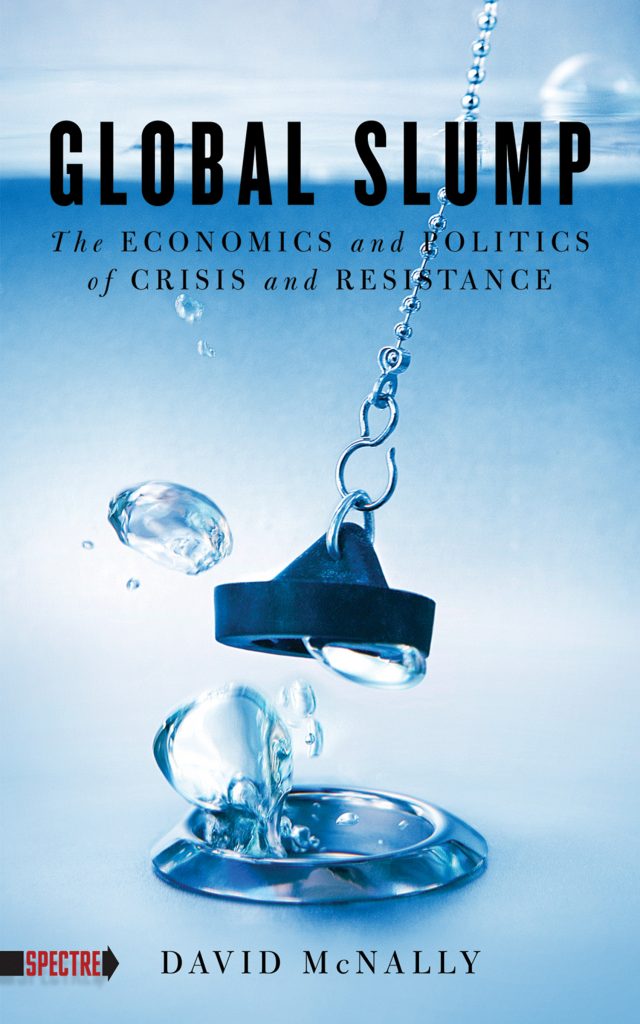by Bill Burgess, Kwantlen Polytechnic University
Socialist Studies 8 no. 1 (Winter 2012), 239-295
David McNally’s prognosis in Global Slump seems exactly right:
Rather than describing a single crisis, the term [global slump] is meant to capture a whole period of interconnected crisis—the bursting of the real estate bubble; a wave of bank collapses; a series of sovereign debt crises; relapses into recession—that goes on for years without sustained economic recovery. This, I submit, is what confronts us for many, many years to come (8-9).
My
attention was drawn to two points in this book. The first is an
important nuance in McNally’s discussion of the crisis. The second is
his original explanation of the reasons for financialization.
Like
most Marxists, McNally roots the current financial crisis in capitalist
over- accumulation. The “majority” assumption is that there has been a
more or less continuous “bust” in capitalist profits since the 1970s. In
contrast, Global Slump insists that our understanding of the
current crisis must acknowledge that a genuine profit “boom” occurred
between 1982 and 2007.
McNally labels this period a “neoliberal
expansion” (38). This draws attention to historically-specific factors
that are often left out of accounts guilty of the complaint that
Marxists have correctly predicted ten of the last three great
depressions. The emphasis on neoliberalism suggests that rising
exploitation may be an important determinant of the crisis. Too many
explanations focus one-sidedly on over-investment in machinery.
Attention
to rising exploitation also sets the stage for the significance of the
“predatory inclusion” (121) of more and more people into financial
markets. McNally describes how “sub-prime” mortgages in the United
States disproportionately targeted poor people of colour. The
indebtedness of developing countries quadrupled during the neoliberal
boom (127). He emphasizes that credit can offset the dampening effect on
consumer demand of rising exploitation. For example, McNally argues
that the end of the neoliberal boom was signalled by the 1997 Asian
Crisis but massive credit expansion postponed the broader crisis to
2007.
I perceive a partial disconnect between this attention to
rising exploitation and ballooning credit and the book’s description of
over-accumulation in the chapter titled “Manic Depression: Capitalism
and its Recurring Crises.” The chapter explains that “mechanization is
necessary to . . . win the battle of price competition . . . as the
ratio of labour to total investment declines, so the ratio of profit to
total investment will tend to fall” (77-78). The glossary entry for
“over-accumulation” reports that it is “caused by intense competition to
boost the productiveness of their companies by investing in new plants
and technologies” (196).
Readers are directed in a footnote to a
forthcoming work which will point out that “the actual process is more
complex, with a variety of counter-tendencies. But this explanation does
justice to a key part of the dynamics at work” (212). Well yes and no,
because as Marx wrote, “to try to explain them [capital’s laws] simply
as the results of competition therefore means to concede that one does
not understand them” (quoted in Lebowitz 2010, 284). McNally (1999) has
himself made this point against “horizontal” (inter-firm) accounts of
over-accumulation in place of “vertical” (inter-class) accounts. For the
fuller, “vertical” explanation I think the chapter needed to include
the “problem” of realizing surplus value. This is where rising
exploitation and credit nicely fit.
Global Slump
identifies the other key element of the neoliberal expansion as the
dramatic capitalist expansion in East Asia, especially in China. McNally
highlights the dramatic proletarianization of the Chinese peasantry and
the massive foreign investment attracted by the precarious position of
these urban migrants. “China’s working class, today at 750 million . . .
is one and a half times larger than the labour force of all the thirty
rich countries of the OECD combined. The country’s surplus labour force
alone is three times larger than the entire manufacturing workforce of
the OECD countries” (52).
It may be that “tendencies towards
over-accumulation and declining profitability . . . have become central
features of China’s market-driven-development” (57). But the implication
seems to be that this process of over-accumulation is the same as in
wealthy capitalist countries. How do we then evaluate the influence of
the Chinese state on the dynamics of the economy, on investment and
demand? The statistic that “China’s 250,000 millionaire households,
making up only 0.4 percent of the population, now control 70 percent of
the country’s wealth” (57) caught my eye. I followed the sources to
determine that the 70 percent actually refers to household wealth, not
all wealth. It had been cited for a discussion on social inequality, so
it was also my mistake to have read it too literally with other issues
in mind. But my point about this experience is the need for more clarity
on the particular structure and dynamics of an economy so central to
global capitalism.
The second main point I got from Global Slump is McNally’s explanation of financialization.
The
numbers are always impressive. Financial returns in the US rose from 16
percent of total profits in 1973 to 41 percent in 2007 (86). Trading in
foreign currencies increased from twice the value of trade in goods to
70 times by 1995. “Over-the-counter” trade in derivatives grew from $1.2
trillion in 1992 to $4.2 trillion in 2007 (94). McNally provides a
clear, understandable description of the various and often esoteric
financial instruments – derivatives, collateralized debt obligations,
credit-default swaps and the like.
He then briefly outlines a
distinctive theory about the origins of financialization. It emphasizes
the “historic transformation of world money that occurred after 1971,
when the US government ended the convertibility of dollars for gold”
(10). With no relatively stable reference point for value, the need
arose for insurance-like protection against the resulting fluctuation in
currencies and interest rates in the context of globalized production
and sales. Thus, financialization does not flow from opportunities
created by deregulation. It is rooted in the objective need of
globalized capitalism for a measurable standard of value. McNally does
not discuss it in these terms, but this sounds like an orthodox Marxist
theory of money that had been challenged by the end of the gold
standard.
In addition to trying to clarify the nature of the crisis, Global Slump
was written to “think through what all this means for movements of
resistance, struggles for social justice, and anticapitalist politics”
(ix). In his second-last chapter McNally tries to “chart pathways of
resistance and anticapitalist transformation” (10) by reviewing recent
movements to occupy factories, general strikes in Guadeloupe and
Martinique, social uprisings in Bolivia and Oaxaca and mobilizations of
immigrants in the US. He emphasizes that the anticapitalist Left must
“reclaim democracy—radical, direct democracy in particular—as a core
value” (189).
McNally’s review of the contours of resistance from
below depicts the commonality of struggles against neoliberal
capitalism in imperialist and imperialized countries. Some of us would
distinguish the context of these struggles more than he apparently
considers necessary.
For example, the issue of anti-imperialism
is not developed in his account of the “mass anti-neoliberal upsurges
toppled governments and rolled back privatizations in countries like Bolivia, Ecuador and Venezuela” (152). The discussion of anti-neoliberalism and anti-capitalism leaves out the governments placed in power by the above upsurges, and projects like the Bolivarian Alliance for the Americas (ALBA) and the Universal Declaration of the Rights of Mother Earth.
This is an important book to read, especially for its distinctive explanation of the economic crisis.
References
Lebowitz, Michael A. Following Marx: Method, Critique and Crisis. Boston: Brill, 2009.
McNally, David. “Turbulence in the World Economy.” Monthly Review 51, no. 2 (1999), http://monthlyreview.org/1999/06/01/turbulence-in-the-world-economy.







